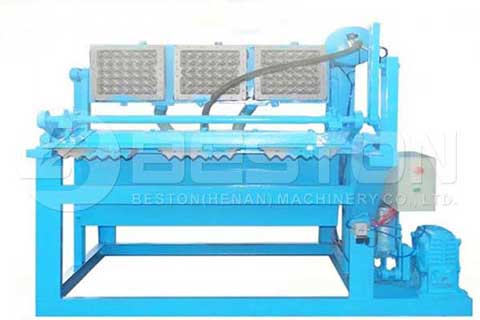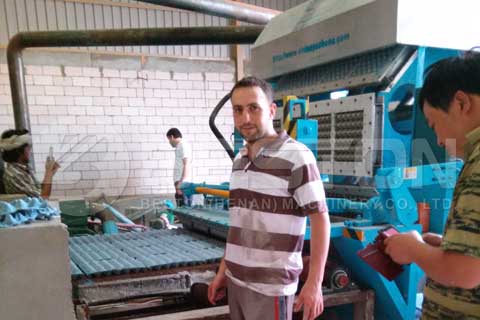Naturally, an egg has its own protective material which is the shell. However, the shell is not strong enough to shield it against excess stress and this gives the need for extra packaging of an egg tray. Egg trays are very important in maintaining the quality of eggs during transportation and storage before it reaches the market. These packaging materials can either be made of paper or plastic. In an attempt to conserve the environment and also minimize costs while maximizing output, more emphasis has currently been put on the production of egg trays made of paper. Let’s, therefore, take a look at the paper egg crate making machine used in making egg cartons and trays.
Features of Egg Carton Making Machine
The parts of an egg tray making machine are classified into two i.e. primary and auxiliary parts. The primary parts are the main parts that make up the machine and they include;
a)The mould- it is the template that gives the desired shape of pulp moulding. The mould is made of a metal sieve and a metal plate at its base. It consists of both suction and transfer moulds. For transfer mould, its inner part is lined with foam for easy detachment of pulp when being transferred.

b)Counter mould- located on the upper part of the machine, its function is transferring the moulded product from the transfer mould to the drying chamber. Though similar in shape, it is bigger than the mould. It consists of a base box that has an outlet from pressure source to the vacuum pump. Its inner side is splashed with foam to ensure no loss of tiny pulp fiber giving an egg carton of smooth surface.
c)Pulp slurry vat- this is an open cylindrical container with fairly dense liquid or gas under atmospheric pressure. It is located on the lower part of the egg carton making machine and it’s where the pulp slurry is moulded. Its huge volume and rigidity allows it to handle slurry with a consistency of 5-10 per cent and withstand stock agitation during forming respectively: https://www.bestongroup.com/apple-tray-making-machine/.
d)Lowering mechanism- consists 4 pipes running between the slurry vat and the counter-mould to allow movement of mould between the two. It also has an overhead shaft where pressure is applied manually to control the movement of the mould either upward or downwards.
Auxiliary part; this is the backup of the machine and is composed of vacuum pump, electric motor and an auxiliary tank. The electric motor is used to drive the vacuum pump and its size varies depending on the machine size. The auxiliary part is crucial for the working of the
machine.

How Does the Machine Work?
The process of how to make egg trays manually can be divided into various stages:
a)Preparation of pulp stock; this is the first step and it involves collection of waste paper which can be pre-consumer or post-consumer paper. The pre-consumer paper is that which comes from the paper factory but is discarded before it reaches the consumer while the post-consumer refers to already used products like old newspapers, cartons or magazines. The waste paper is converted to pulp using hydropulper and then mixed with adequate water giving a suspension of the required consistency. The pulp is then poured into the auxiliary tank.
b)Product wet forming and de-watering; vacuum pump is then powered allowing vacuum to build up in the vacuum chamber. The suction mould that is connected to a source of sub atmospheric pressure is now lowered into the holding tank containing the suspension. As a result, the suspension is deposited into the suction mould. Here the suspension will be moulded into the desired shape of an egg tray. A de-watering fluid is then passed through the mould to remove excess water thereby increasing the dry matter content of the article.
c)Transfer of the wet product; afterward the suction mould is disconnected from the sub-atmospheric pressure source and brought into contact with the transfer mould. To separate the two, the suction mould is lowered leaving the wet pulp egg trays attached to the transfer mould.
d)Collection and drying of the egg trays; for the collection, a tray is placed below the transfer mould where the egg trays are deposited then taken out for drying using automatic, semi-automatic or brick drying line. Drying can also be done in the sun.
Advantages of Egg Carton Making Machine
- Cheap and easily accessible raw materials –waste paper can be found everywhere whether they be old books, newspapers or discarded cartons at very affordable prices.
- Reasonable initial capital – purchasing an egg carton making machine requires less capital thus maximizing profits.
- Promotes environmental conservation by recycling used paper thus reducing deforestation.
Reading more information about the advantages of this machine, you can visit the website of Beston Company now.